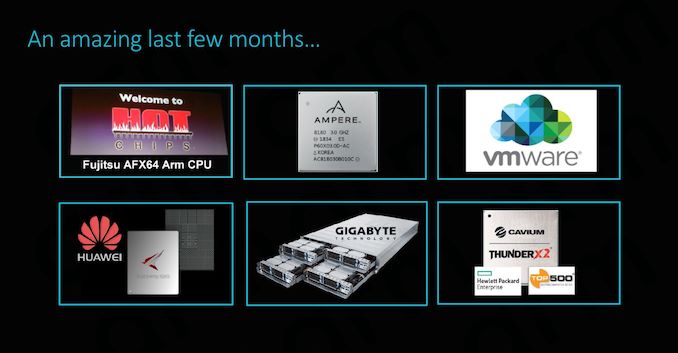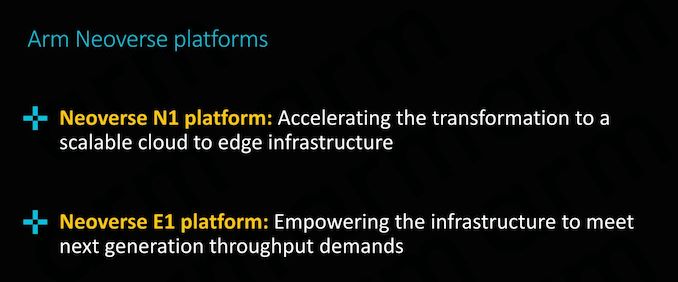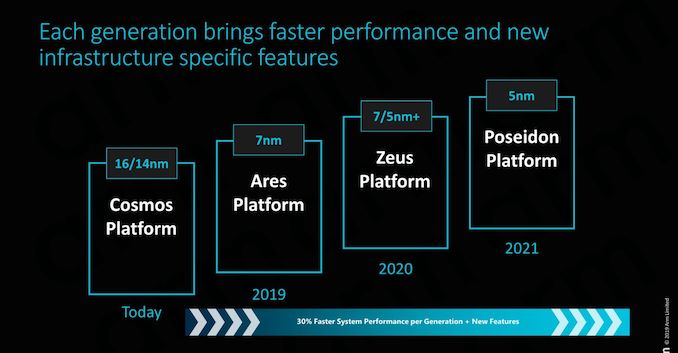Arm Announces Neoverse N1 & E1 Platforms & CPUs: Enabling A Huge Jump In Infrastructure Performance
by Andrei Frumusanu on February 20, 2019 9:00 AM EST
Anybody following the industry over the last decade will have heard of Arm. We best know the company for being the enabler and providing the architecture as well as CPU designs that power essentially all of today’s mobile devices. The last 7-5 years in particular we’ve seen meteoric advances in silicon performance of the mobile SoCs found in our smartphones and tablets.
However Arm's ambition goes widely beyond just mobile and embedded devices. The market for compute in general is a lot larger than that, and looking at things in a business sense, high-end devices like servers and related infrastructure carry far greater profit margins. So for a successful CPU designer like Arm who is still on the rise, it's a very lucrative market to aim for, as current leader Intel can profess.
To that end, while Arm has been wildly successful in mobile and embedded, anything requiring more performance has to date been out of reach or has come with significant drawbacks. Over the last decade we’ve heard of numerous prophecies how products based on the architecture will take the server and infrastructure market by storm “any moment now”. In the last couple of years in particular we’ve seen various vendors attempt to bring this goal to fruition: Unfortunately, the results of the first generation of products were less than successful, and as such, even though some did better than others, the Arm server ecosystem has seen a quite a bit of hardship in its first years.
A New Focus On Performance
While Arm has been successful in mobile for quite some time, the overall performance of their designs has often left something to be desired. As a result, the company has been undertaking a new focus on performance that is spanning everything from mobile to servers. Working towards this goal, 2018 was an important year for Arm as the company had introduced its brand-new Cortex A76 microarchitecture design: Representing a clean-sheet endeavor, learning from the experience gained in previous generations, the company has put high hopes in the brand-new Austin-family of microarchitectures. In fact, Arm is so confident on its upcoming designs that the company has publicly shared its client compute CPU roadmap through 2020 and proclaiming it will take Intel head on in PC laptop space.
While we’ll have to wait a bit longer for products such as the Snapdragon 8CX to come to market, we’ve already had our hands on the first mobile devices with the Cortex A76, and very much independently verified all of Arm’s performance and efficiency claims.
And then of course, there's Neoverse, the star of today's Arm announcements. With Neoverse Arm is looking to do for servers and infrastructure what it's already doing for its mobile business, by greatly ramping up their performance and improving their competitiveness with a new generation of processor designs. We'll get into Neoverse in much deeper detail in a moment, but in context, it's one piece of a much larger effort for Arm.
All of these new microarchitectures are important to Arm because they represent an inflection point in the market: Performance is now nearing that of the high-end players such as Intel and AMD, and Arm is confident in its ability to sustain significant annual improvements of 25-30% - vastly exceeding the rate at which the incumbent vendors are able to iterate.
The Server Inflection Point: An Eventful Last Few Months Indeed
The last couple of months have been quite exciting for the Arm server ecosystem. At last year’s Hotchips we’ve covered Fujitsu’s session of their brand-new A64FX HPC (High performance compute) processor, representing not only the company shift from SPARC to ARMv8, but also delivering the first chip to implement the new SVE (Scalable Vector Extensions) addition to the Arm architecture.
Cavium’s ThunderX2 saw some very impressive performance leaps, making its new processor among the first to be able to compete with Intel and AMD – with partners such as GIGABYTE offering whole server systems solutions based on the new SoC.
Most recently, we saw Huawei unveiled their new Kunspeng 920 server chip promising to be the industry’s highest performing Arm server CPU.
The big commonality between the above mentioned three products is the fact that each represents individual vendor’s efforts at implementing a custom microarchitecture based on an ARMv8 architectural license. This in fact begs the question: what are Arm’s own plans for the server and infrastructure market? Well for those following closely, today’s coverage of the new Neoverse line-up shouldn’t come as a complete surprise as the company had first announced the branding and road-map back in October.
Introducing the Neoverse N1 & E1 platforms: Enabling the Ecosystem
Today’s announcement is all about enabling the ecosystem; we’ll be covering in more detail two new “platforms” that will be at the core of Arm’s infrastructure strategy for the next few years, the Neoverse N1 and E1 platforms:
Particularly today’s announcement of the Neoverse N1 platform sheds light onto what Arm had teased back in the initial October release, detailing what exactly “Ares” is and how the server/infrastructure counter-part to the Cortex A76 µarchitecture will be bringing major performance boosts to the Arm infrastructure ecosystem.













101 Comments
View All Comments
Andrei Frumusanu - Wednesday, February 20, 2019 - link
> It also shows a result showing Zen roughly half the performance of IntelThe W-3175X was at 4.5GHz with the whole 38MB of L3 for the one thread, while the 7601 ran at a peak of 3.2GHz.
Meteor2 - Wednesday, February 20, 2019 - link
I wish you’d normalised for frequency!Andrei Frumusanu - Wednesday, February 20, 2019 - link
That's not the point of the article.ZolaIII - Wednesday, February 20, 2019 - link
Next time read twice before posting. AVX on integer benchmark really?Wilco1 - Wednesday, February 20, 2019 - link
Of course. Never heard of how SIMD hugely affects libquantum for example?Andrei Frumusanu - Wednesday, February 20, 2019 - link
AVX works on integer ...ZolaIII - Wednesday, February 20, 2019 - link
The era of general purpose core's being used for HPC is long time gone. While general purpose core's are hire to stay they will do that with modest number of core's per system, the real push is towards special purpose and multi purpose accelerators. FPGA's being put in the first row because their reprogrammable nature. The ARM actually have an edge over the CISC (X86) because it's simply more efficient which having stellar integer performance for the size of the core. If you look at the development bord it's very clear ARM is pushing into right direction.Meteor2 - Wednesday, February 20, 2019 - link
Kind of. But bottom line is the 20-odd codes used predominantly in the world still run best on general purpose CPUs. Bending software to work on specialised architectures is really hard.ZolaIII - Thursday, February 21, 2019 - link
On the FPGA you bend hardware. That's the whole idea.wumpus - Thursday, February 21, 2019 - link
HPC traditionally meant double precision FLOPS. AI work or similar might want FPGAs until GPUs are sufficiently ready for such things (then FPGA can't keep up).FPGAs are painfully slow at what they do, but can take an entirely new architecture on the fly. We saw that with cryptomining as things went CPU->GPU->FPGA->ASIC. And if you need a lot of multiply-accumulate (like most AI), don't expect anything between GPU and ASIC.